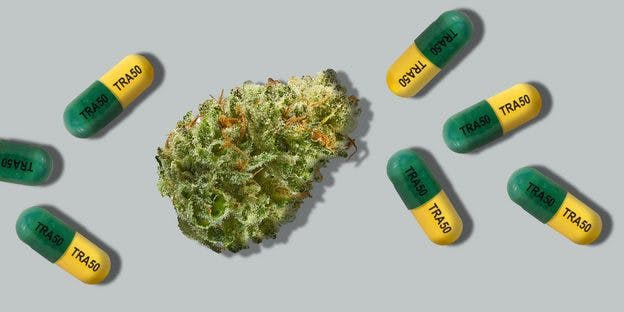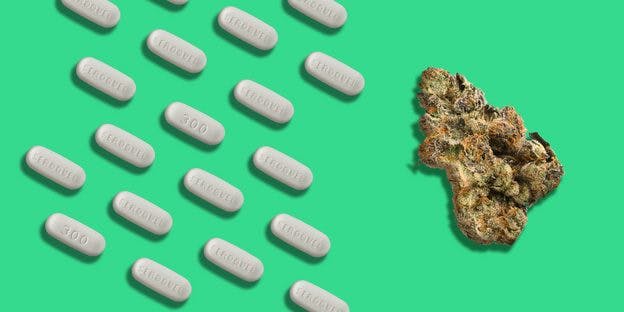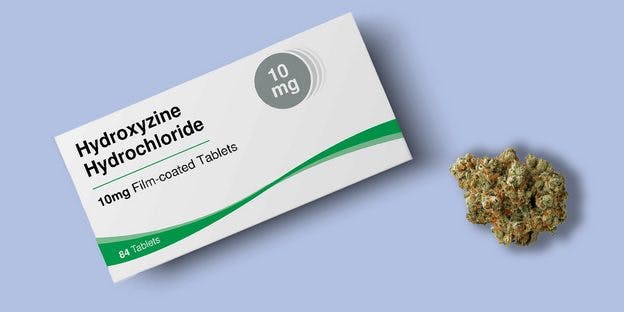Should You Use Marijuana If You Use Tramadol?

Article written by

Shanti RyleContent Writer
Content reviewed by

Dr. Lewis JasseyMedical Director - Pediatric Medicine
Tramadol is a potent, potentially addictive opioid prescription medication used to treat pain related to injury and recovery. Cannabis is also highly valued for its potential pain-relieving abilities, which could theoretically compound the relief provided by tramadol. Cannabis can also increase the sedative effects of tramadol, which can cause an increased risk of harmful side effects when used together, like dry mouth and respiratory depression (potentially deadly slowed breathing). Cannabis and tramadol are listed as having a significant drug-drug interaction.
If you’re currently using tramadol and considering cannabis use, it’s essential to look at your reasons for using each. The drugs don’t operate on the same pathways in the body, but you should still use extreme caution and consult a physician before combining cannabis and tramadol. The two substances interact, and you may need to reduce your tramadol intake if combined with medical cannabis.
Get your medical marijuana card
Connect with a licensed physician online in minutes.
What Is Tramadol?
Tramadol is an opioid-based medication sold under brand names including Ultram, Rybix ODT, and ConZip. Doctors prescribe tramadol to treat moderate to severe pain that’s expected to last no longer than six months, which makes it different from other opioids used continuously to treat chronic pain.
Tramadol isn’t the most popular prescription painkiller in the U.S., but doctors still commonly prescribe it for injury or short-term pain management. Like other opioids, it carries its risks: in 2011, tramadol was linked to over 54,000 emergency visits nationwide.
Download Free Guide to Marijuana and Chronic Pain
Uses and How It Works
Tramadol operates by influencing distinct physiological mechanisms, such as binding to opioid neural receptors, which modulate the experience of pain. Tramadol is also a partial serotonin and norepinephrine reuptake inhibitor, commonly classified as an antidepressant.
Like many other opioid drugs, tramadol carries a high potential for addiction and drug addiction. It can lead to adverse side effects and withdrawals if use suddenly stops or expands outside the scope of a doctor’s prescription.
Potential Benefits and Risks of Mixing Cannabis and Tramadol
Potential Benefits
While little research covers the chemical interactions of tramadol and marijuana in the body, some studies and conjecture support their co-use. Cannabis for chronic pain is one of the primary reasons cited for its recommendation in the U.S. and works via a different pathway than opioids: the endocannabinoid system (ECS). However, there is a major drug-drug interaction between the two, so great care must be taken concerning dosing. Moreover, cannabinoids also influence the behavior of opioid receptors.
A 2019 study showed that combining morphine and a synthetic form of THC in monkeys offered a safer treatment to opioid medication users, lowering the required dose and risk of substance abuse while showing no significant impact on impulsivity or memory impairment.
Cannabis may be a good option for individuals seeking to lower high-level doses or reliance on tramadol, allowing them to achieve the same pain relief without developing dependence. A 2018 review paper collected evidence to support cannabis use to ease withdrawal symptoms of opioid use disorder, mitigate overall consumption and cravings, and ultimately reduce overdose deaths.
Download Free Guide to the ECS
Potential Risks
Only one study examined potential adverse effects from combined cannabis and tramadol, which found no severe complications outside of issues with calcium reabsorption.
However, the danger in the reckless consumption of tramadol and weed lies in the depression of the central nervous system (CNS). Opioids are a class of CNS depressants, and some varieties of cannabis have depressant effects.
Because both cannabis and tramadol impair cognition and memory, one may underestimate the amount of tramadol in their system and take too much. It’s impossible to overdose on cannabis, but it’s entirely possible to overdose on tramadol. CNS depression can lead to decreased heart rate, decreased breathing, and loss of consciousness, potentially resulting in coma or death.
The Bottom Line
Even though the research is scarce, the pain-relieving properties of medical marijuana make it an attractive alternative to higher doses of tramadol when the drugs are taken in tandem. If you’re looking to add cannabis to your tramadol regimen, be conscious of planning out dosing and gradually adjusting the intake of each drug. Go slowly, observe the effects and always consult with a physician before making changes.
Speak with one of Leafwell’s qualified physicians and apply for your medical marijuana card online in minutes.
Get Your Medical Card
Connect with a licensed physician online in minutes.


